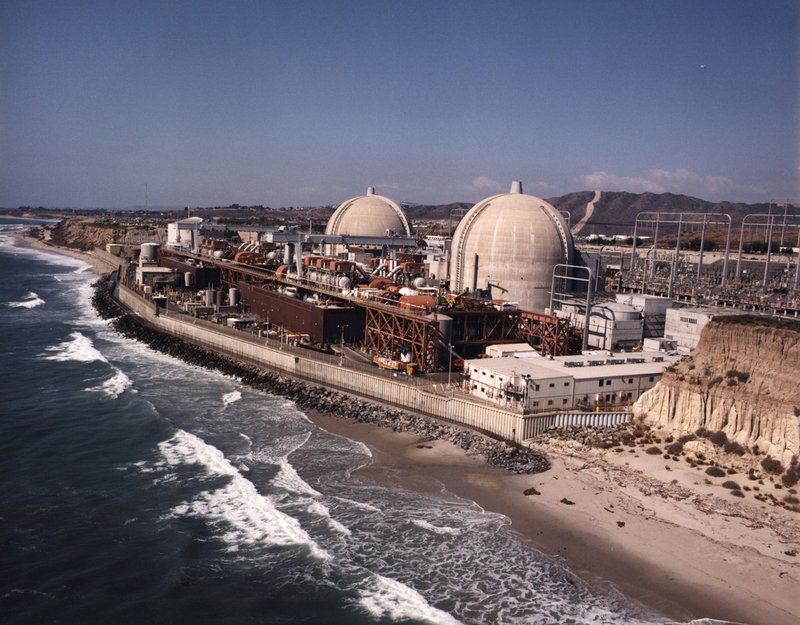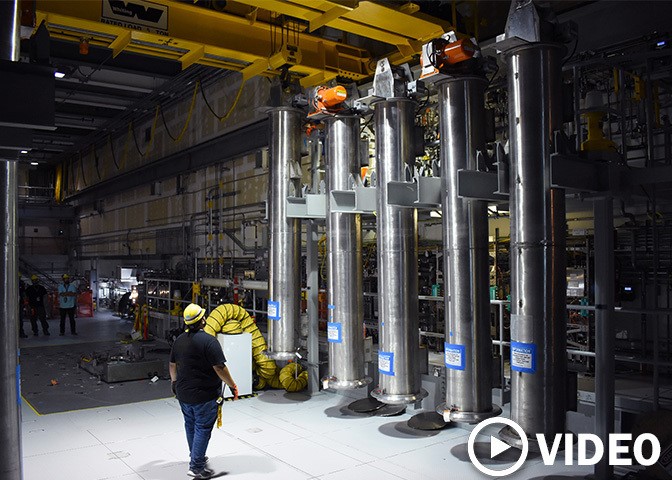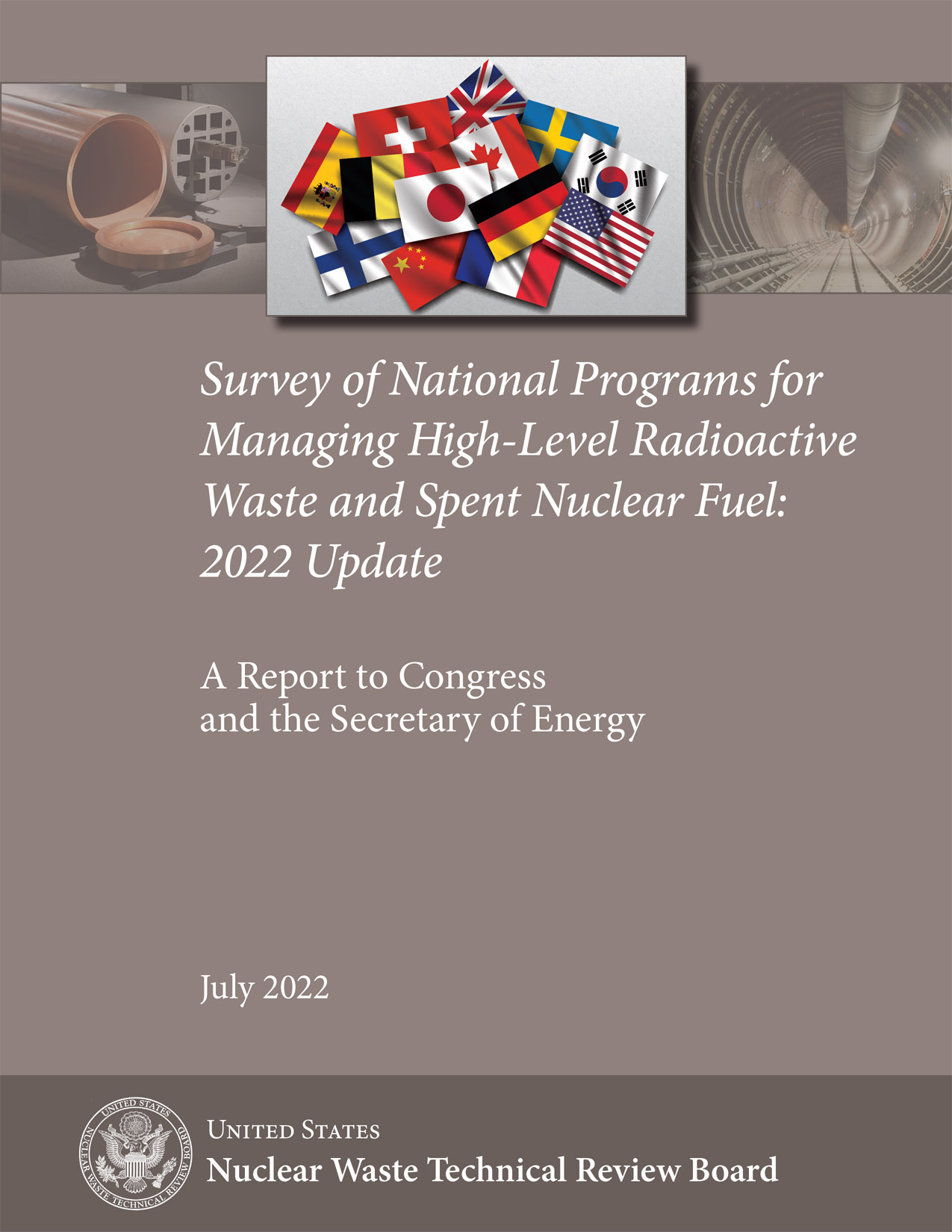Retention basins at the Liquid Effluent Retention Facility on the Hanford Site, as seen in September 2021, at top, and recently with the nearly completed Basin 41 on the far left. (Photo: DOE)
Work is nearing completion on a fourth basin needed to ensure adequate storage for wastewater during tank waste treatment on the Department of Energy’s Hanford Site, in Washington state.
According to the DOE, its operations contractor Washington River Protection Solutions (WRPS) has made significant progress on Basin 41 at the Liquid Effluent Retention Facility (LERF) since concrete was first poured for the perimeter one year ago.
Video: Watch this time-lapse video of the LERF Basin 41 construction.
The San Onofre nuclear power plant.
The San Onofre Nuclear Generating Station (SONGS) recently shared a few videos on its YouTube channel, showing recent progress Southern California Edison has made in dismantling the plant’s turbine building. Decommissioning of the nuclear power plant, which permanently ceased operations in 2013, is being conducted by SONGS Decommissioning Solutions, a joint venture of EnergySolutions and AECOM.
A worker watches test bubblers in operation at the Hanford Site. (Photo: DOE)
The B Farm underground waste tank area at Hanford. (Photo: DOE)
Washington state’s Department of Ecology and the U.S. Department of Energy have agreed on a plan for how to respond to two underground tanks that are leaking radioactive waste, as well as any future tank leaks, at the Hanford Site near Richland, Wash.
In April 2021, following a year-long leak assessment, the DOE announced that Hanford’s Tank B-109 is leaking waste into the surrounding soil. Tank T-111 was discovered to be leaking in 2013. Currently, Tank B-109 is leaking about 1.5 gallons of waste per day, and Tank T-111 is leaking less than a gallon a day, according to the DOE.
The Solid Waste Management Facility at the Savannah River Site. (Photo: DOE)
The Solid Waste Management Facility (SWMF) at the Department of Energy’s Savannah River Site recently was subject to an enhancement program designed to improve procedure format and quality. The program has led to a greater efficiency and a streamlined procedure review process at the facility, according to the DOE’s managing and operating contractor at SRS.
Crews begin clearing the site on which Savannah River Site’s SDU 10 will sit. (Photo: DOE)
The Department of Energy’s Office of Environmental Management (EM) announced that it is preparing for construction of the final three planned saltstone disposal units (SDUs) at the Savannah River Site in South Carolina, which will complete the site’s liquid waste mission.
The SRS liquid waste contractor, Savannah River Mission Completion (SRMC), is overseeing the construction of the SDUs, which will receive decontaminated salt solution treated at Savannah River’s Salt Waste Processing Facility (SWPF).
Ontario’s South Bruce area is being considered as a potential host site for a spent fuel repository. (Photo: NWMO)
Canada’s Nuclear Waste Management Organization (NWMO) is shifting the timing for selecting a preferred site for a spent nuclear fuel repository to the fall of 2024, a full year later than previously planned. The NWMO, a nonprofit organization tasked with the safe, long-term management of Canada’s spent fuel in a deep geological repository, said the delay is the result of several provincial lockdowns associated with the COVID-19 pandemic.
Hanford workers will soon begin retrieving about 373,000 gallons of waste from Tank AX-101, shown here in an image from an inspection video shot. (Photo: DOE)
Washington River Protection Solutions (WRPS) is preparing to retrieve waste from Tank AX-101 at the Department of Energy’s Hanford Site near Richland, Wash. WRPS is the tank operations contractor at Hanford.
Schematic of a deep horizontal borehole repository for nuclear waste. (Image: Deep Isolation)
Deep Isolation announced that it has signed a memorandum of agreement with engineering services company Amentum to further the commercialization of Deep Isolation’s nuclear waste storage and disposal technology around the world. The initial targets for joint work include locations in Europe and the Pacific that represent a combined market for geologic disposal of spent fuel and high-level waste worth more than $30 billion, the company said.
A contamination suit provided by the EM Nevada Program is on display in the new exhibit at the National Atomic Testing Museum. (Photo: DOE)
The Department of Energy’s Office of Environmental Management (EM) celebrated the opening of a new exhibit at the National Atomic Testing Museum in Las Vegas during a ceremony on August 2.
Created through a partnership between EM and the museum, the permanent exhibit, “Beyond the Manhattan Project: Cleaning up the Legacy of America’s Nuclear Defense and Research Missions,” offers a visual display of EM’s critical work to clean up sites across the country impacted by five decades of nuclear weapons production and government-sponsored nuclear energy research.
A DUF6 storage cylinder is moved at the Portsmouth DUF6 conversion facility. (Photo: DOE)
The Government Accountability Office is recommending that Congress clarify the Department of Energy’s legal authority to sell depleted uranium hexafluoride (DUF6) left over from uranium enrichment operations at the department’s Portsmouth Site in Ohio and the Paducah Site in Kentucky.
A worker replaces a manipulator arm at the Savannah River’s SWPF. (Photo: DOE)
Savannah River Mission Completion (SRMC), the radioactive liquid waste contractor at the Department of Energy’s Savannah River Site, is optimizing some equipment maintenance at the Salt Waste Processing Facility (SWPF). The facility traditionally uses centrifugal contactors in the solvent extraction process, and its laboratory uses manipulators to handle process samples and equipment within its radioactive cell. The equipment requires periodic maintenance and rebuilding.
The reactor hall at the Halden research reactor. (Photo: Westinghouse)
Westinghouse Electric Company was awarded an engineering contract with Norsk Nukleær Dekommisjonering (NND) to plan the decommissioning of the country’s two nuclear research reactors, located in Halden and Kjeller. The three-year agreement includes options up to six years and is valued at up to $100 million (NOK 1 billion).
A rendering of Holtec’s proposed HI-STORE CISF in New Mexico. (Image: Holtec)
The Nuclear Regulatory Commission has published its final environmental impact statement (EIS) for Holtec International’s proposed HI-STORE consolidated interim storage facility (CISF) for spent nuclear fuel in southeastern New Mexico. Based on its environmental review, the NRC staff recommends issuing the license, subject to the findings in the staff’s ongoing safety review of the application.

















 The Nuclear Waste Technical Review Board has issued a report to the U.S. Congress and the secretary of energy examining the programs for managing spent nuclear fuel and high-level radioactive waste in more than a dozen countries.
The Nuclear Waste Technical Review Board has issued a report to the U.S. Congress and the secretary of energy examining the programs for managing spent nuclear fuel and high-level radioactive waste in more than a dozen countries.
